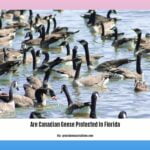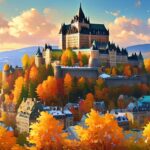Journey with us as we delve into the captivating secrets of the Everglades, a diverse and enigmatic ecosystem that holds a wealth of hidden wonders. Prepare to be amazed as we unveil the intriguing facts that lie within this extraordinary natural marvel, a true testament to Florida’s rich biodiversity. [Unveiling the Everglades: A Treasure Trove of Hidden Wonders] promises an unforgettable exploration of the unique treasures found in this iconic ecosystem.
Key Takeaways:
The Everglades is massive, spanning 11,100 square kilometers.
It’s the largest subtropical wilderness in the U.S.
This unique ecosystem has earned recognition as a UNESCO World Heritage Site and Wetland of International Importance.
The Everglades provides a safe haven for 16 endangered species.
Before Europeans arrived, this land belonged to the native Calusa and Tequesta tribes.
Humans have called the southern part of Florida home for an impressive 15,000 years.
The Everglades goes from flooding in the wet season to drought in the dry season.
Fun Facts About Florida Everglades
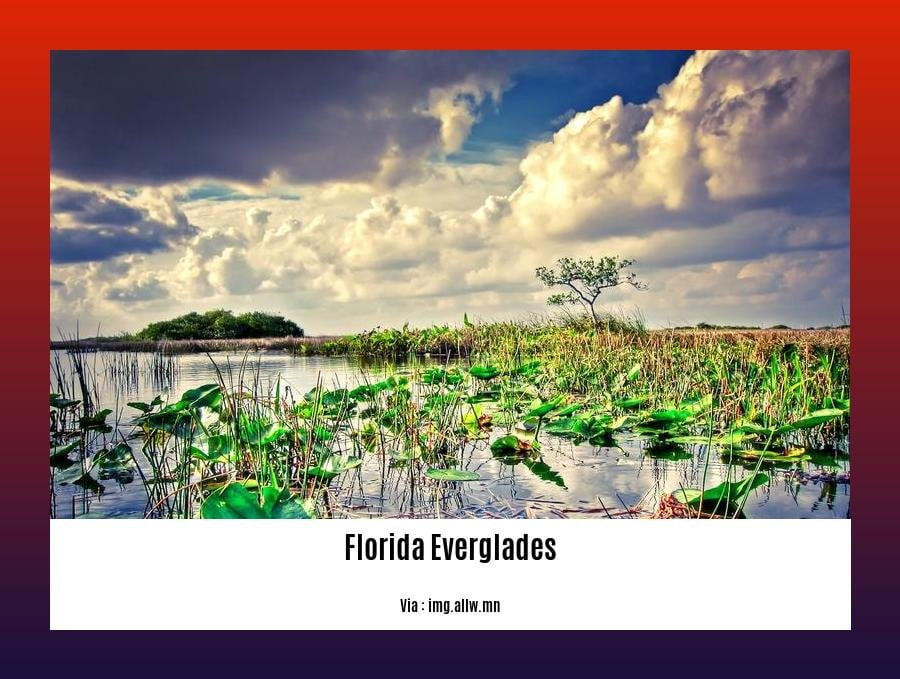
In the heart of Florida, a sprawling sanctuary called the Everglades beckons explorers with its captivating beauty and ecological wonders. This unique ecosystem boasts a treasure trove of hidden gems and intriguing secrets, inviting us to uncover its enchanting mysteries. Let’s delve into some fascinating fun facts about this remarkable natural treasure:
The River of Grass
- Imagine a river, not of water, but of grass! The Everglades truly lives up to its moniker, “The River of Grass.” This vast expanse of sawgrass swaying gently in the breeze creates a mesmerizing sea of green, stretching as far as the eye can see.
A Haven for Wildlife
- The Everglades is a vibrant haven for an incredible diversity of wildlife, providing a safe haven for endangered species like the Florida panther, American crocodile, and West Indian manatee.
Hidden Aquatic Highways
-Beneath the shimmering surface of the Everglades, a network of hidden waterways known as ‘sloughs’ weaves its way through the sawgrass prairies. These aquatic paths serve as vital transportation routes for fish and other aquatic creatures.
The Ghost Orchid’s Elusive Beauty
- Amidst the lush vegetation, a rare and elusive treasure flourishes – the ghost orchid. This ephemeral bloom emerges from the treetops, captivating all who catch a glimpse of its delicate, ghostly petals.
Dance of the Fireflies
- As darkness descends upon the Everglades, a magical spectacle unfolds. Myriads of fireflies light up the night sky, their synchronized flashes creating an enchanting dance of light.
Ancient Crossroads
-Before European colonization, the Everglades was home to thriving indigenous communities, such as the Calusa and Tequesta tribes, who left an enduring legacy in the form of shell mounds and intricate canals.
A Symphony of Sounds
-The Everglades is alive with a symphony of sounds. From the haunting cries of the limpkin to the gentle chirping of the endangered snail kite, each sound contributes to the rich tapestry of the Everglades’ natural soundtrack.
A Balancing Act
- This delicate ecosystem plays a crucial role in maintaining Florida’s water supply, acting as a natural filter that purifies water as it slowly flows through the Everglades’ vast wetlands.
A Canvas of Colors
- The Everglades transforms throughout the year, painting a canvas of vibrant colors. In the dry season, the landscape takes on a golden hue, while the wet season brings forth an explosion of lush greenery.
Ever-evolving Beauty
-The Everglades is a dynamic and ever-changing ecosystem, shaped by the interplay of water, plants, and animals. Its beauty lies in its constant transformation, offering new discoveries and surprises with every visit.
Join the chorus of voices celebrating the wonders of the Everglades, a place where nature’s secrets unfold, inviting us to explore, learn, and appreciate the marvels of this extraordinary ecosystem.
Who would not be curious about the compelling history of one of Latin America’s most captivating cities? Dive into our intriguing article on fun facts about Buenos Aires to discover its eclectic past and vibrant present.
Want to delve into the local stories and hidden gems that make Buenos Aires so unique? Uncover a treasure trove of interesting facts about Buenos Aires in our comprehensive guide, and prepare to be captivated by the magic of this enchanting city.
The Everglades is a critical water source for South Florida, providing drinking water for millions of people and supporting agriculture in the region.
There’s so much to know about the Everglades, but let’s focus on its water supply: it’s a mighty lifeline for South Florida, offering drinking water for millions and supporting the region’s agriculture.
Picture this: an extensive network of marshes, swamps, and rivers winding their way through the heart of South Florida. This slow-moving river of grass is the famed Everglades. Its water doesn’t rush; it meanders, filtering and purifying as it goes, becoming the lifeblood of the region’s environment and economy.
For millions of South Floridians, the Everglades is their water source. The water seeps through layers of rock and soil, accumulating in vast underground reservoirs. Then, wells tap into these reservoirs and bring that pure, filtered water to homes and businesses across the region. This reliable and abundant supply has made the Everglades a critical water resource for South Florida.
But that’s not all. Agriculture, a pillar of the region’s economy, relies heavily on the Everglades water. Fields of sugarcane, tomatoes, and other crops thrive on the steady flow of water from the Everglades. Farmers tap into canals and channels that distribute the water across their vast fields, ensuring their crops get the hydration they need to flourish.
The Everglades water supply is a gift that keeps on giving. It provides drinking water for millions, sustains agriculture, and supports a vibrant ecosystem. It’s a testament to the power of nature and its ability to nourish and sustain life.
Without the Everglades, South Florida would be a very different place. It would be a region parched for water, struggling to sustain its population and economy. But with the Everglades, South Florida thrives, its people and industries flourishing in the embrace of this remarkable natural resource.
It’s our duty to protect and preserve the Everglades, ensuring its waters continue to flow for generations to come.
Key Takeaways:
- The Everglades provides drinking water for eight million Floridians, serving as a critical water source for South Florida.
- It supplies water for agriculture, supporting the region’s economy and ensuring the availability of fresh produce.
- The Everglades water is a vital resource, sustaining South Florida’s environment and economy.
References:
[1] Everglades History, Conservation & Sightseeing (evergladesholidaypark.com)
[2] Protecting the Everglades | National Wildlife Federation (nwf.org)
The Everglades: A Thriving Ecotourism Destination
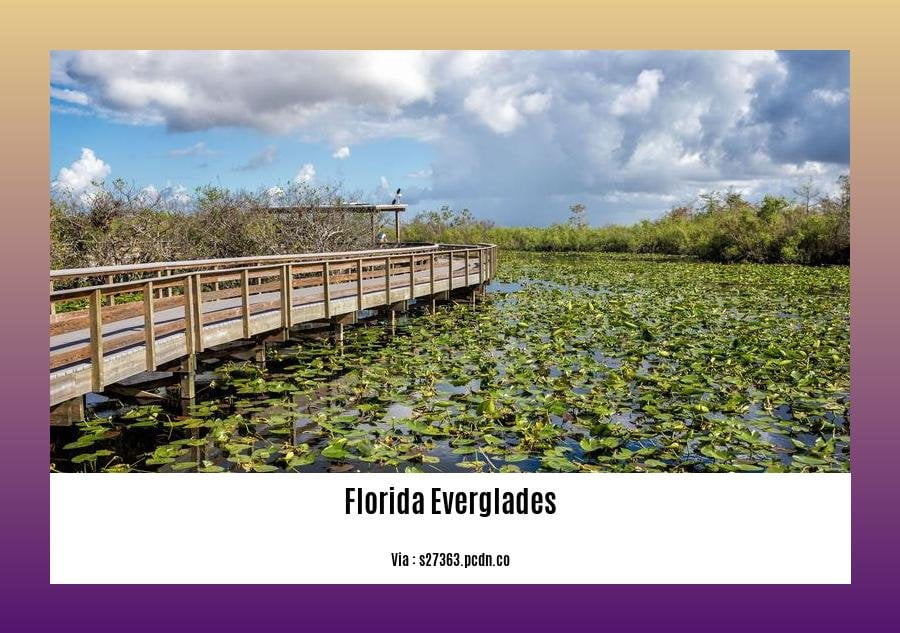
Key Takeaways:
The Everglades boasts the title of being North America’s largest subtropical wilderness, encompassing a vast 1.5 million acres.
Recognized for its ecological significance, the Everglades has earned the prestigious designation of a UNESCO World Heritage Site.
This extraordinary ecosystem provides a vital sanctuary for an array of rare and endangered species, including the elusive Florida panther.
Beyond its natural wonders, the Everglades plays a pivotal role in sustaining the region, serving as a natural water filter and supplying drinking water to millions of Floridians.
Historically, the Everglades’ waters flowed naturally, nourishing diverse habitats along their journey. However, human intervention in the early 1900s altered this flow, impacting the ecosystem’s delicate balance.
Ecotourism in the Everglades
The Everglades is a popular destination for ecotourism, offering visitors an unforgettable opportunity to immerse themselves in the beauty and biodiversity of this unique ecosystem. Whether you prefer gliding through the sawgrass prairies on an airboat, hiking amidst the lush vegetation, or paddling through tranquil waterways in a kayak, the Everglades offers a range of activities that cater to every nature enthusiast.
Airboat Tours:
Embark on an exhilarating airboat ride, a signature experience in the Everglades. These specially designed boats skim effortlessly over the shallow waters, providing an up-close encounter with the diverse wildlife that calls this ecosystem home. Keep your eyes peeled for alligators basking in the sun, turtles basking on logs and wading birds taking flight above the marsh.
Hiking Trails:
Lace up your hiking boots and explore the Everglades’ vast network of trails that wind through a variety of habitats, from pine flatwoods to hardwood hammocks. As you venture deeper into the wilderness, you’ll be surrounded by the symphony of nature—the calls of birds, the rustle of leaves, and the gentle splash of water.
Kayaking Adventures:
For a more intimate experience with the Everglades’ waterways, embark on a kayaking adventure. Glide along the tranquil sloughs and canals, immersing yourself in the serenity of nature. Paddle past lush vegetation, encounter playful otters, and witness the graceful ballet of birds in flight.
Tips for Ecotourists:
Respect the Wildlife: Remember that you are a guest in the Everglades. Observe wildlife from a distance and avoid disturbing their natural behavior.
Leave No Trace: Practice the principles of Leave No Trace by packing out all your trash and minimizing your impact on the environment.
Support Sustainable Businesses: Choose tour operators that prioritize sustainability and conservation efforts. Your support can help preserve the Everglades for future generations.
Conclusion:
The Everglades, with its breathtaking landscapes, diverse wildlife, and rich cultural heritage, offers an unparalleled ecotourism experience. As you explore this remarkable ecosystem, remember to embrace the spirit of conservation and become a steward of this natural treasure.
Relevant URL Sources:
– https://www.evergladesholidaypark.com/about/everglades/
–
The Everglades is facing significant threats from climate change, pollution, and invasive species, making conservation efforts more important than ever.
The Everglades, a vast and iconic ecosystem, is under siege from multiple threats, including climate change, pollution, and invasive species. These challenges pose significant risks to the unique biodiversity and ecological integrity of this remarkable natural wonder.
Climate Change
Climate change is having a profound impact on the Everglades. Rising sea levels are causing saltwater intrusion into the freshwater Everglades, which is harming plants and animals. Rising temperatures are leading to more frequent and intense storms, which can cause flooding and damage to park infrastructure. Changes in precipitation patterns are affecting the timing and duration of the wet and dry seasons, disrupting the natural cycle of the Everglades ecosystem.
Pollution
Pollution from various sources, including agricultural runoff, urban development, and industrial activities, is also harming the Everglades. Fertilizers and pesticides from farms can contaminate waterways, causing algal blooms and harming fish and wildlife. Chemicals from industrial activities can also pollute the water and air, affecting the health of both humans and wildlife.
Invasive Species
Invasive species, such as the Burmese python and the melaleuca tree, are also posing a significant threat to the Everglades. These non-native species can outcompete native plants and animals for resources, leading to their decline or even extinction. Invasive species can also alter the structure and function of the Everglades ecosystem, disrupting its natural balance.
Conservation Efforts
Conservation efforts are more important than ever to protect the Everglades from these threats. These efforts include:
- Restoring wetlands: Restoring wetlands helps to filter pollutants from the water and provides habitat for native plants and animals.
- Planting trees: Planting trees helps to reduce erosion and provides food and shelter for wildlife.
- Controlling invasive species: Controlling invasive species helps to protect native plants and animals and restore the natural balance of the Everglades ecosystem.
- Reducing pollution: Reducing pollution helps to improve the water quality of the Everglades and protect the health of humans and wildlife.
Key Takeaways:
- Climate change, pollution, and invasive species pose significant threats to the Everglades.
- Rising sea levels, more frequent and intense storms, and changes in precipitation patterns are the main impacts of climate change on the Everglades.
- Pollution from agricultural runoff, urban development, and industrial activities is harming the Everglades.
- Invasive species, such as the Burmese python and the melaleuca tree, are outcompeting native plants and animals.
- Conservation efforts, such as restoring wetlands, planting trees, controlling invasive species, and reducing pollution, are crucial to protect the Everglades.
Sources:
- Climate Change Impacts on the Everglades
- Pollution in the Everglades
FAQ
Q1: What is the significance of the Everglades?
A1: The Everglades holds immense ecological importance as North America’s largest remaining subtropical wilderness, providing refuge to a diverse array of rare and threatened species, including the elusive Florida panther, and serving as a crucial water source for millions of Floridians.
Q2: Why is the Everglades considered unique?
A2: The Everglades stands out for its unique ecosystem, characterized by a diverse mosaic of habitats ranging from cypress swamps and wet prairies to mangroves, supporting a vibrant community of plant and animal life adapted to the region’s unique hydrology and water flow patterns.
Q3: How does the Everglades contribute to Florida’s environment?
A3: The Everglades plays a vital role in sustaining Florida’s environment by naturally filtering water, providing flood control, and recharging groundwater supplies. Its vast wetlands act as a natural buffer, mitigating the impacts of storms and hurricanes on coastal communities.
Q4: What are some of the fun facts about the Everglades?
A4: Among the many intriguing facts about the Everglades is its designation as both a UNESCO World Heritage Site and a Wetland of International Importance, recognizing its global significance. It is also home to the largest population of American alligators in the world and hosts a diverse array of bird species, including the iconic roseate spoonbill.
Q5: What are the biggest threats facing the Everglades today?
A5: The Everglades faces several pressing threats, including the impacts of climate change, such as sea-level rise and altered weather patterns, which disrupt the ecosystem’s delicate balance. Invasive species, habitat loss due to development, and pollution from agricultural runoff further contribute to the challenges confronting this unique natural treasure.
- SYBAU See You Baby Meaning: Gen Z Slang Evolves - July 1, 2025
- Unlock Your Inner Youth: Lifestyle Secrets for a Vibrant Life - July 1, 2025
- Decode SYBAU Meaning: Gen Z Slang Explained - July 1, 2025
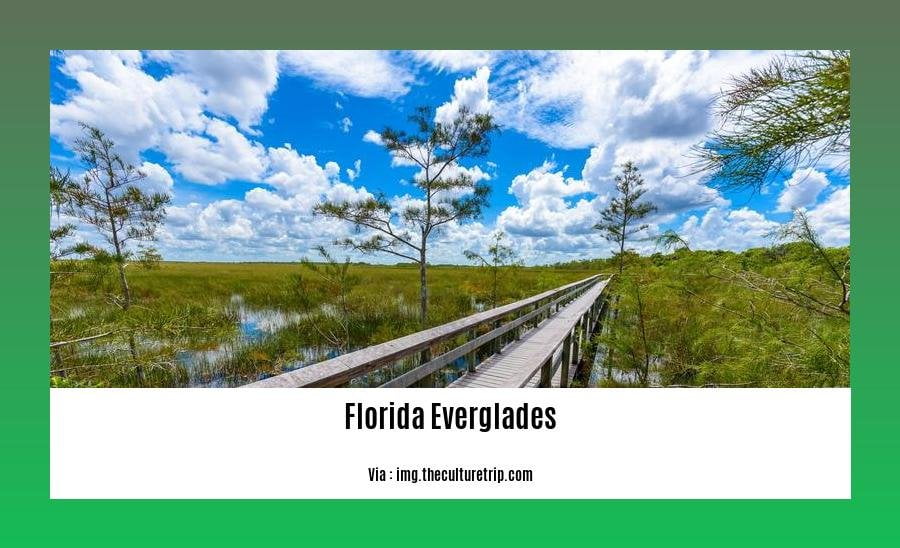
![[Facts about Florida Everglades]: Unveiling the Wonders of a Unique Ecosystem Facts-about-Florida-Everglades_2](https://www.lolaapp.com/wp-content/uploads/2023/12/Facts-about-Florida-Everglades_2-150x150.jpg)
